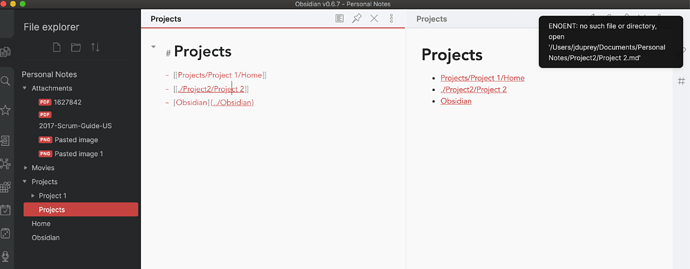I really like Obsidian’s approach to using an open format for notes (markdown) and a very standard format of storage and content organization (folders). Tying all this together, in a semantic way, are the Markdown links between these documents.
If I were to use this for work, my knowledge base would consist of notes and supporting documents of various other formats (office docs, pdfs, …). I really like that I can add and edit the content from outside of Obsidian (from iOS, or other apps on the same machine.)
What seems to be missing, are two things:
- The ability to build the folder structure from links to pages that don’t exist. e.g. [[./Project 1/Home]] when command clicked should create the “Project 1” folder (relative to the current page’s location) and then the new note “Home.md”. In stead I get:
- “No such file or directory”. I could create the structure manually, but this definitely slows down the process.
- Bringing images and other content (Attachments) in to the note from drag and drop or copy and past is great! However, it could be better if attachment placement was more… localized. Right now, I believe, attachments are either dumped at the top level or in an Attachments folder that you can specify. It’d be great if it went in a local Attachments folder next to the the markdown file.
Without being able to manage content through a folder hierarchy, I can’t see how very large knowledge bases can be managed over time in anything but the Obsidian app - using other tools would struggle with a flat directory of 100’s or 1000’s of files.
For a reference, I dumped my work Bear App notes to Markdown. I have over 1800 markdown files, with 4900 total files if you count attachments/files.
In case you are wondering what that looks like in Obsidian…
Most of the larger clusters are clipped web pages with many outgoing links.
9 Likes
… based on other posts, I do suspect that the general consensus is that the folder structure is secondary - an underlying technical detail that avoids lock in to inaccessible databases. The recommendation would be to build rich inter-linked content, and semantic hierarchies via “index pages”.
I get it, it just makes it more challenging when not working in Obsidian and trying to work with the same content.
2 Likes
You seem to have a huge electronic brain, my friend…
You’re not the only one who would like to see some better folder management. For example, see this request: Set default attachment folder for "same folder as the file is in" or there are a couple more requests from here: Nested folders
What you’re asking for makes sense, and with the rapid pace of development, it’s impossible to say how long it will take, but I’m sure we’ll see similar things in the future.
2 Likes
My “electronic brain” are my bear notes - a year’s worth exported just to see what Obsidian would do wit hit. Tbh. Its a mess. There are meeting notes that should be archived or deleted. Every topic deserves review and pruning…
Mixed in all that noise is knowledge that I rely on. Bear’s excellent editor, super fast search, easy hierarchical tags, and smart page linking (even if I rename the page!) allow me to keep on top of everything.
I’m glad I’m not alone. I don’t don’t think the page creation is “right” (for me). That aspect has to get much better. I also don’t feel like Markdown as an user interface is necessarily the best experience, though I like Markdown as a compatibility format and as editor shortcuts - a la Bear.
I’ve been wanting something a little less… proprietary? … but I’ve yet to find anything with the speed and simplicity as Bear. I will keep an eye on Obsidian and hope it improves in the areas mentioned. Having a notes/knowledge base that can live in my filesystem along with my other project artifacts w/ tagging and wiki-like linking… definitely seems powerful on the surface.
Mac / iOS only though. Not an option if you’re intending to use it in a future-proof team.
Obsidian is still very raw, agreed.

